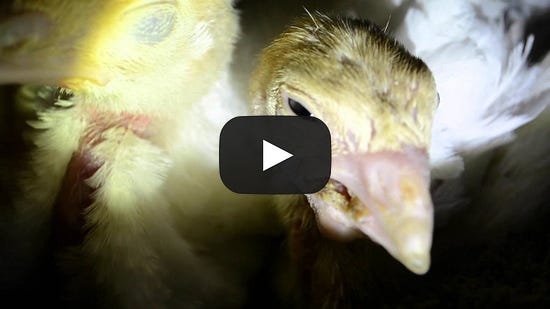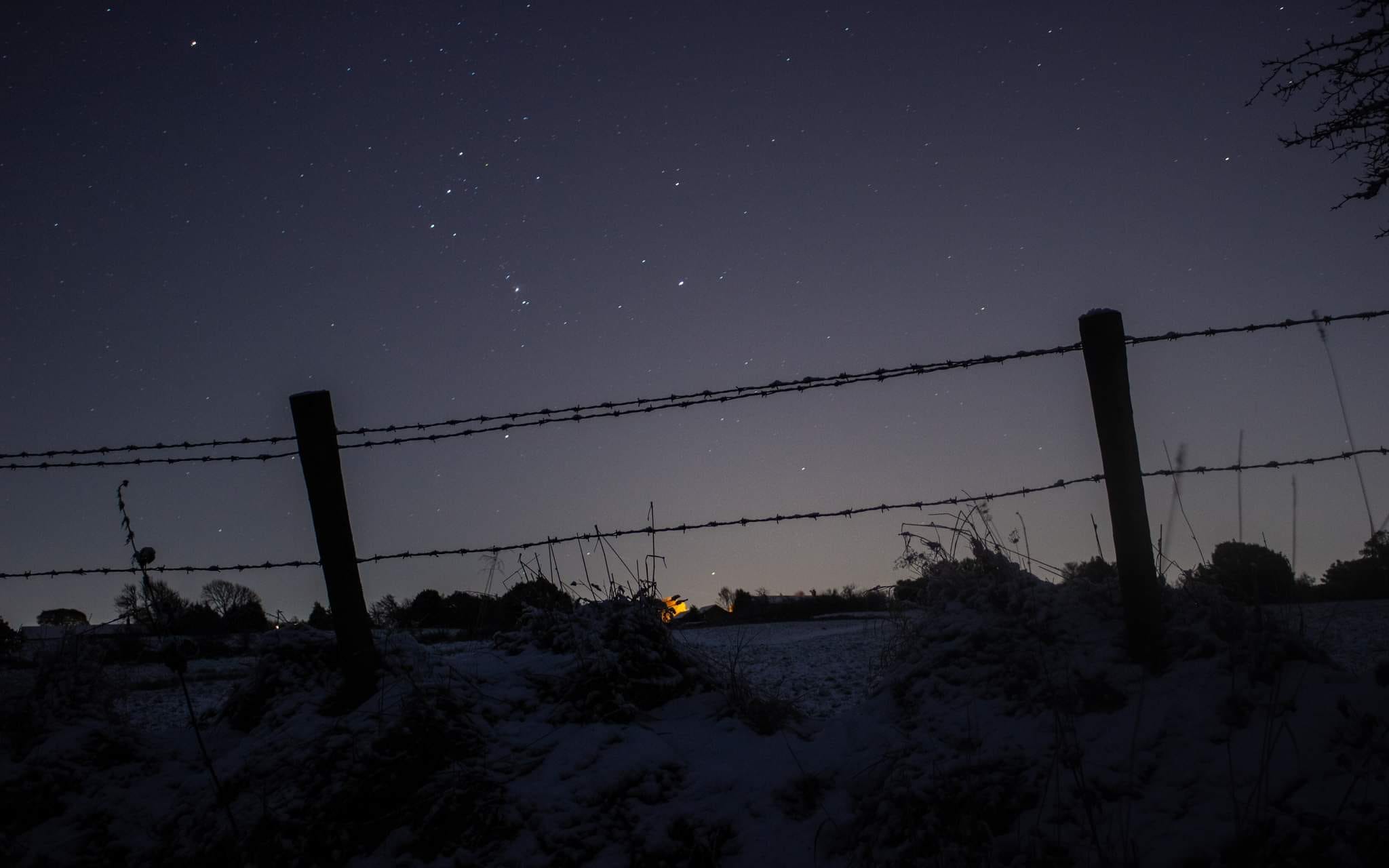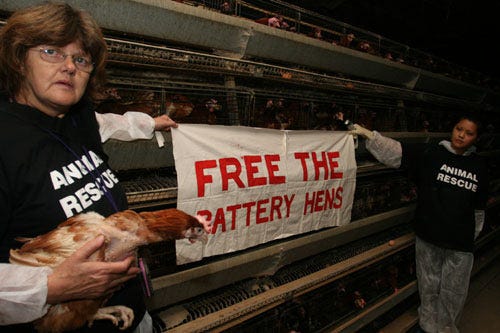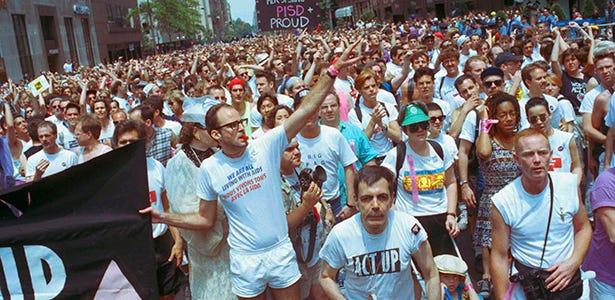|
Why We Need to Cross Dangerous Lines
Patty Mark crossed the line that separates human and non-human animals thirty years ago. What she saw terrified her – but also triggered a movement for change.
What’s up this week
What if the solution to the nation’s mental health crisis, and its stalling movements for change, can be found in crossing dangerous lines? That is the lesson from the life of Patty Mark, who walked into a factory farm at a time when everyone was afraid. I break it down in today’s newsletter below.
Over a dozen animals were rescued from Perdue Farms by DxE activists at the Animal Liberation Conference. The Intercept reports that diseases were found at the facility, including many that are dangerous to human consumers, such as “necrotic enteritis.”
“That is the moral force of an idea whose time has arrived” - in this week’s New York Times. This week’s column by Nick Kristof describes the tremendous progress we’ve made in animal rights since Peter Singer published Animal Liberation in 1975. It’s a must-read.
Patty Mark will be joining the first meeting of Open Rescue Advocates on June 25. She’ll be sharing lessons from 30+ years of open rescue, including the story of the first open rescue in history. Don’t miss it!
The cure for fear
The world is safer than it has ever been. Yet, across the nation, people — especially young people — are increasingly afraid.
This was the controversial assertion made by psychologist Jean Twenge in 2017. But in the 6 years since, the evidence has only strengthened that something has gone deeply wrong in the nation’s anxiety and mental health, and not just with the young. As NPR reports:
"Every indicator of mental health and psychological well-being has become more negative among teens and young adults since 2012," Twenge writes in Generations. "The trends are stunning in their consistency, breadth and size."
Across the board, since 2010, anxiety, depression and loneliness have all increased. "And it's not just symptoms that rose, but also behaviors," she says, "including emergency room visits for self-harm, for suicide attempts and completed suicides."
There have been countless explanations for why fear and anxiety are on the rise: smart-phone-induced disconnection (Twenge’s preferred hypothesis), social media’s impacts on our feelings of self worth (an assertion backed by a new study by an MIT economist), or the decline in social support structures, such as churches or bowling clubs (the argument of a renowned Harvard social scientist).
What is less discussed, though, is solutions.
That is why Patty Mark’s story is even more important today. Because what Patty teaches is that, if we are to heal ourselves or the world around us, we cannot follow the advice that modern life gives us: seek safety above all else. The drumbeat of “safe spaces” and “self-care” does not actually lead us to feel more settled or safe. Instead, it traps us in an echo chamber of fear. To the contrary, the solution to fear isn’t safety. It’s bravery, i.e., crossing lines that seem dangerous. And, in many cases, the more dangerous the line, the more therapeutic the impact of crossing it — not just for individuals but for our society as a whole.
Crossing the species line
When Patty Mark first began crossing the line that separates human from non-human animals in the early 1990s, by walking into factory farms to give aid to the individuals suffering within, the practice was unheard of. While there had been so-called “underground” actions to rescue animals by the Animal Liberation Front (ALF) since the 1980s, the actions were decried by mainstream society as criminal, leading to the passage of the Animal Enterprise Protection Act in 1992. Even those ALF actions, moreover, were focused on laboratories and fur farms. The thought of using radical direct action tactics to target the meat industry — a system that ordinary people participated in — seemed foolhardy if not counterproductive.
And yet that is exactly what Patty began to do: enter places where farm animals were being tortured and killed, at great personal and legal risk. And when she crossed that dangerous line, what she saw struck terror in her heart:
During the past 30 years I have been stepping across the line that humans draw to separate us from other animals. I hear their screams and witness their fear and suffering in hundreds of places including slaughterhouses, industrialized farms, darkened sheds, open paddocks, feedlots and inside transport trucks/ships on four continents. There was nothing humane on their side of the line.
But something surprising happened to Patty, and has happened to so many others who have crossed that dangerous line. Even as the suffering was overwhelming. and the risk great, walking into those places gave her a sense of purpose. The many fears the movement was facing at the time — rejection by a meat-eating public, criminal prosecution by corrupt governments — seemed small in comparison to the torment she was witnessing. And while the abuse of animals was disturbing, it was also immediately obvious that she had the power to stop it. In Patty’s early visits to Australian egg farms, she carried countless starving animals, collapsed in the manure piles underneath the farm, to sanctuary. Crossing that dangerous line, in short, gave her purpose and power.
This is something I have witnessed time and time again with my own experiences with open rescue. The danger of the mission rarely traumatizes people. To the contrary, it empowers them to see their own strength.
Take, for example, “Roger” (a pseudonym). Roger was a shy and soft-spoken software engineer when I met him in 2014. He told me repeatedly, “I’m not an activist. I don’t have it in me.” Initially, most of his participation in activism involved computers and spreadsheets. But when he joined us for the first time in the Diestel open rescue, it was as if he had been completely transformed. Serving as lookout, he huddled in the cold in a ravine outside of the turkey ranch, watching for farm security in the middle of the night. When we came back with a little bird, rescued from the brink of death, the look on his face was triumphant.

Almost immediately upon returning from those first few open rescue missions, Rogers’s demeanor transformed. He went from fearful to confident; he suddenly began smiling and laughing with people, even when he had just barely met them; and he told me months later, “That was the moment. That was the moment when I realized I’m part of this, and I can create change.” Crossing a dangerous line made him stronger.
There is evidence that this effect is a general one, far beyond Roger, Patty, or the issue of animal rights. The standard treatment for PTSD, as established by a half century of evidence, is to push patients to confront the very triggers that cause them trauma, and therefore become systematically desensitized to the trigger’s negative impact. And the psychologist Jonathan Haidt has documented how various forms of “exposure therapy” are crucial to maintaining individual mental health.
Courage, in short, breeds more courage.
Communicative suffering
There’s another element to Patty’s open rescue, however, that is just as important: it’s ability to create not just personal but social transformation. You see, sometimes when we cross a dangerous line, we don’t just recognize our individual purpose and power. We blaze a trail for others to follow — and take our entire society into a new and better place.
This has been true of social movements for the last few hundred years. The forefathers of the American republic crossed dangerous lines when they tossed British tea into the ocean. The antislavery activists of the 1840s crossed dangerous lines when they built the Underground Railroad, risking not just incarceration but violent reprisal for their efforts to give aid to liberated slaves. And the gay rights movement was launched when people started coming out as gay, at the very moment in history when (due to the AIDS crisis) being openly gay was seen as not just immoral but dangerous.
In all of these cases, social change came about precisely because people were willing to take risks. One Oxford scholar has described this as “communicative suffering.” When activists are willing to bear some risk of harm themselves, it’s a signal to the rest of the world to pay attention. And the power of communicative suffering is one of the primary reasons open rescue has had such a dramatic impact on animal rights history. When we cross dangerous lines, people can’t help but pay attention.
Indeed, in some cases, they are transformed.
One of the things we’ve heard from jurors , after the two historic victories we’ve won for the right to rescue, is an appreciation for the activists’ sacrifice. Lynn, a juror in Utah, told us, “These two guys are risking their freedom for their cause. The least I can do is listen.” But Lynn did not just listen; he became an advocate for the right to rescue himself, offering powerful testimony in the Utah legislature and penning an important op ed in the largest newspaper in the state.
The mechanism through which risk creates change, moreover, is similar in both the individual and systemic context. At the individual level, people become less sensitized to fearful triggers when they’re exposed to them. At the social level, an entire society can become more open to a change when an individual — or a movement — takes on great risk to bring a proposed change to life. In both cases, exposure to what’s on the other side of a seemingly dangerous line creates healing and change.
But this process depends crucially on people being willing to cross those lines. And that brings us back to Twenge’s data that I started this newsletter with.
One of her most interesting findings is that there has been a dramatic decrease in the percentage of young people who are willing to sometimes take risks, from 48 percent in 1991 to just 32 percent in 2021. At first glance, this might not seem the most troubling indicator, especially compared to more obviously concerning shifts, such as the increases in depression, loneliness, and suicide. But if we are focused on solutions, and not just problems, this number should be of special concern. Because the only way for many individuals to get out of spirals of despair, or for our society to escape its current doom loop, is for people to take risks. We need people to be brave.
This is what Patty taught us decades ago. And I’m incredibly excited that she’ll be sharing more of those lessons at our first Open Rescue Advocates meeting on June 25. I hope that all of us will learn a few things about how to cross dangerous lines — and make the world a better place by doing so.



